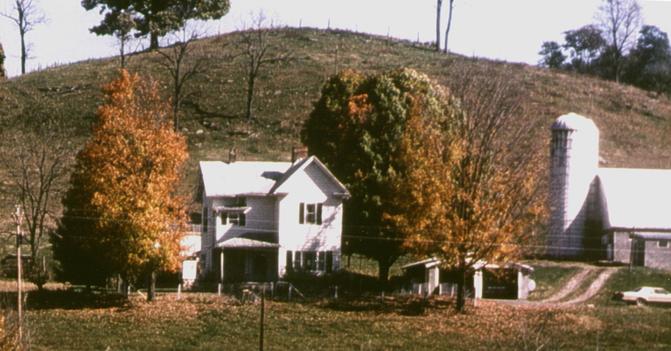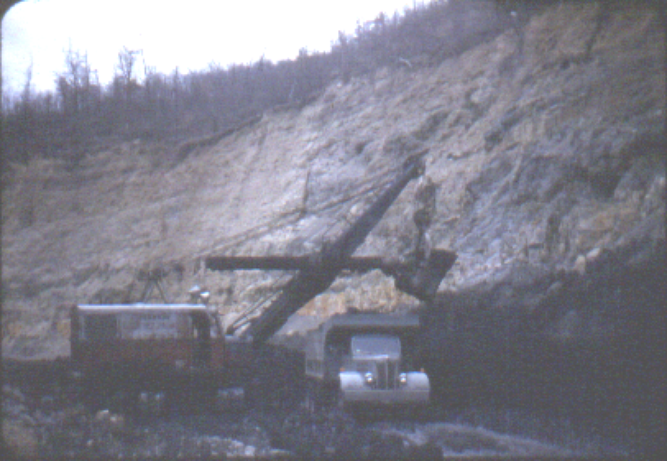
| Next Chapter | Previous Chapter | |
| Chapter 29: Coal I | Contents | Chapter 27: The Oldest Things I know About Our Land |
When I was a teenager there was a distinct gradation of clothes in the generations working in our fields. I never knew my paternal grandfather, but my maternal grandfather wore a shirt with long sleeves buttoned at the wrist. My father wore long sleeve shirts rolled up above his elbows (and had the tan line to show it). Both of these men wore standard wide brim hats, Grandfather's straw, and Dad's felt. Uncle Gene, who was mom's brother, but almost young enough to be Dad's son, rolled his long sleeves up as high as he could, and wore a pith helmet. These were pretty typical of the generations the men represented. I wore short sleeves and no hat when I was in my early teens but wore sunglasses to protect my eyes instead.
People (at least educated people) are now aware of skin cancer and age spots. Many young men of my generation went without shirts while doing hot work, but most of them did not work day after day in the sun the way I did. Eventually, I got to wearing a hat. At first it was a sewn cloth hat like a dress hat, but later, in my early thirties a hard hat, aluminum at first, then the high-impact plastic with hearing protection I now wear. The hearing protection came too late, however, and I have severe hearing loss and tinnitus (ringing in the ears) from too many years on tractors and possibly from listening to the radio in the car while commuting to my teaching job.
We all wore shoes that came up over our ankles, with three or four hooks at the top, rather than eyelets, to facilitate quick lacing and removal. These were affectionately called "clod hoppers' to distinguish them from dress shoes, which did not cover ankle bones. Dress shoes were worn for work after they were not fit for dress wear but did not protect from briers or turned ankles.
I am the only one of these men who lived long enough to realize the danger from sun, unless you say the people of Granddad's generation had a traditional understanding. Women of my grandmother's generation wore "sun bonnets" that extended from six inches in front of their faces on the top and sides to perhaps as much as ten inches for some. Women were very vain about having a light complexion. This wasn't convenient for farm women.
I subscribe to the theory that, at one time in the past, a tan showed you had to work, and the absence of a tan indicated you had status enough to subsist on the labor of others. Coco Channel, the French fashion maven, made a tan fashionable in the 20's and 30's. Obviously the style didn't reach West Virginia in time to influence us because, by that time, the upper class was able to distinguish itself by having leisure to get out in the sun , while the working class had to stay inside to do their work. Farm folk were so "far below the pale" (to coin a phrase) they didn't count to Coco. (We don't hear much about Coco Channel anymore, but Channel #5 perfume is still advertised.)
My mother wore a pith helmet and long sleeved man's shirt to do yard work or work in the garden, and when she was younger, to make hay shocks. She invariably worked the garden in the hottest part of the day, never early or late. We kids had to work with her, because we had to have supervision. I never could understand why she did not work early in the morning or late at night when the temperature was more temperate.
When I was young, in winter my father wore the high lace-up boots popular in WWI days and for several decades after, with wool socks. (See illustration 1-2) Over these in wet weather he wore "Four buckle Arctics," rubber boots with a gusset that allowed them to be removed easily, and buckles to hold them tightly to the foot and lower leg. All through childhood I wore Four buckle Arctics over my shoes to wade the deep mud around the barn when I went to do chores and continued to do so until sometime in the 70s.
(Illustration 28-1)

Mom's Home Place (Grandfather Kennedy's) between Lost Creek and Rockford as it appeared about the time she died.
Hands have always been a big problem in winter. My Grandfather Bond, I am told, owned a pair of gloves. They were not made at home and were considered expensive. He wore them to the barn, took them off to do chores, and then wore them back to the house afterward. Dad always had gloves, the cheap kind that are mostly canvas, with a yellowish nap to improve grip, the kind that were very widely used in industry. I use leather gloves with a polyester fleece lining. I now have a tractor with a cab, but before that, keeping hands warm was always a problem. Mittens, mittens over light gloves, and other combinations, did not keep my hands warm in cold weather when driving three miles on an open tractor in the winter!
When we children were young, my mother sewed a lot because of necessity, mostly for herself and my sisters. I can remember when some of my sister's clothing was made from cotton feed sacks. They were designed for that purpose with appropriate prints. Many kids, especially girls were a beneficiary of this byproduct of the feed industry.
My wife has sewn some, mostly for pleasure. She was a Home Economics major. She made her own wedding dress and also our daughter's, and curtains, as well as clothes. My maternal grandfather, who was extremely poor and had a family of several children, made their shoes. His mother made fancy dress shirts for a (rather poor) living after her husband died. Men's clothing has mostly come from the store in the times I have known. Best clothing was worn to church and special occasions, like Fourth of July celebrations, family reunions, public school functions, etc.
Suits and fancy dresses are now out of style, except for very dressy occasions, like weddings. Every man wears short sleeves in summer. Some churches even discourage dress up clothes. Women's shoes make them look like they planned to go for a hike when they go to work in an office or to school.
Now, in winter I prefer insulated coveralls, and on my head, a knit cap, just like the crusaders wore under their armor, and like the Vikings wore before them. This is a very ancient garment, with a history that extends back into prehistory. When it is below 20 degrees Fahrenheit, felt lined boots help keep my feet warm. I never wear leather footwear unless it is warm and dry, always rubber boots to keep out water. In summer I now wear long sleeves, clodhoppers and a hard hat. I have used 5-Fluorouricil on my forehead and lower face for actinic keratosis, thanks to my youthful abandon in intense sunlight. This medicine removes the pre-cancerous skin changes.
Aside There has been some coal extraction by strip mining in Central West Virginia for a long time. Even when stripping was not an industry, coal was uncovered around mine headings and loaded out for sale. Stripping got started in earnest toward the end of World War II, when there was a tremendous demand for additional coal. The Federal Government demanded that contractors (road builders and others who owned heavy equipment) stop whatever work they were doing, and come to central West Virginia. Contractors came from "Pearl Harbor, the gold fields of the West, Massachusetts, New York, Pennsylvania, Ohio and North Carolina." They mined coal by removing the thin layers of soil and rock over coal near the outer edge of the hills. There were few requirements except to push aside the soil and rock which once covered the coal back to the hill, leaving a 2% grade down toward the hill.
(Illustration 28-2)

The way coal was originally removed from the hill by strip mining.
The first real strip mining anywhere in the United States on industrial scale was in Harrison County. According to the September 1944, issue of Coal Mining magazine, which devoted half the issue to "Coal Stripping in the Clarksburg District of Northern West Virginia," 41 percent of U. S. homes were still heated by bituminous coal, labor turnover in the coal industry was half that in other industries, and coal was cheaper than any other material produced in bulk, except sand and gravel. Stripping undoubtedly prevented rationing of solid fuel during World War II. It was a big industry, and a lot of money was being made by management, labor and companies that supplied equipment and material.
| Next Chapter | Previous Chapter | |
| Chapter 29: Coal I | Contents | Chapter 27: The Oldest Things I know About Our Land |
Copyright © 1998, 2006, 2008, 2011 S. Tom Bond (stombond at hughes.net)